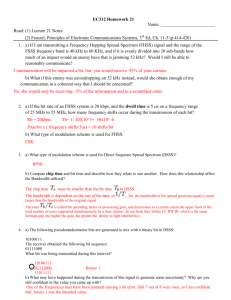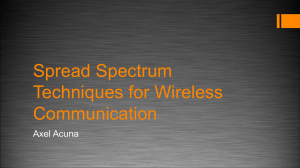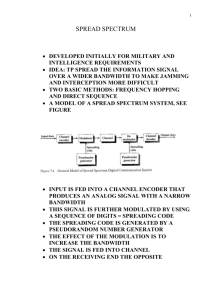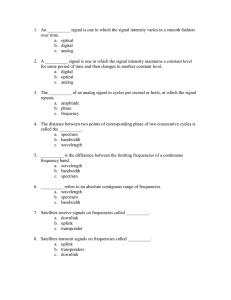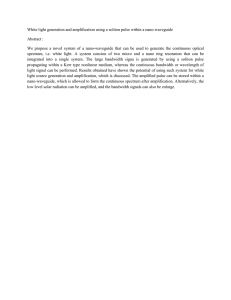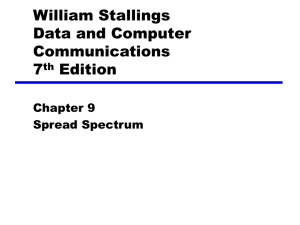Which Spread Spectrum Technology Delivers Better Performance, Direct
advertisement
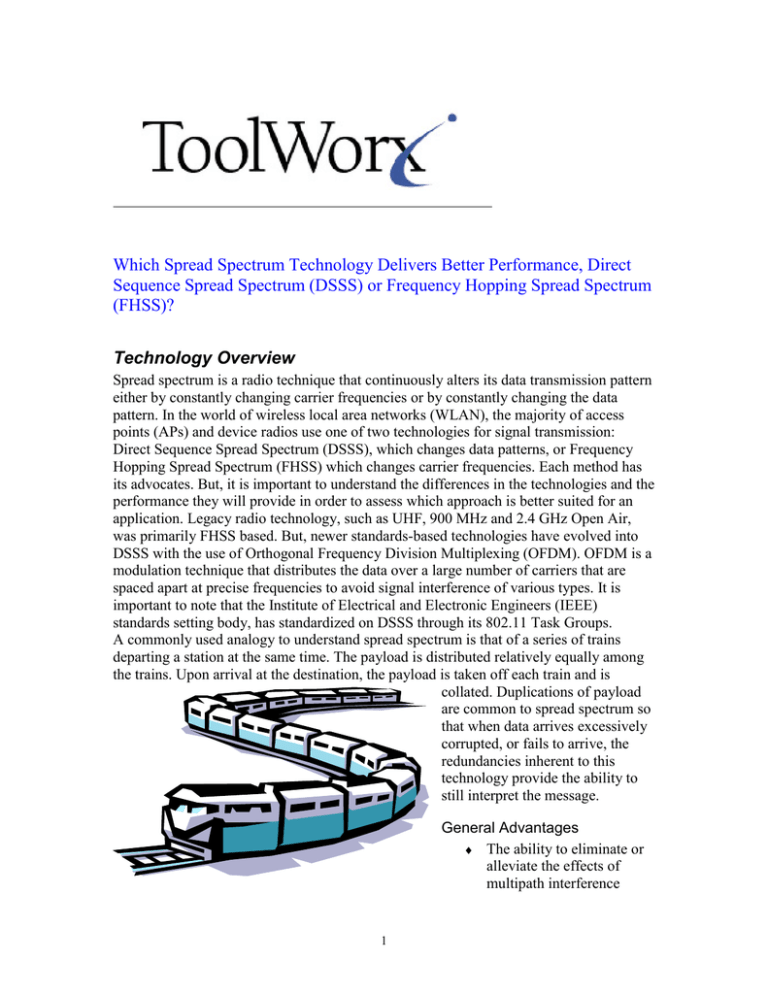
Which Spread Spectrum Technology Delivers Better Performance, Direct Sequence Spread Spectrum (DSSS) or Frequency Hopping Spread Spectrum (FHSS)? Technology Overview Spread spectrum is a radio technique that continuously alters its data transmission pattern either by constantly changing carrier frequencies or by constantly changing the data pattern. In the world of wireless local area networks (WLAN), the majority of access points (APs) and device radios use one of two technologies for signal transmission: Direct Sequence Spread Spectrum (DSSS), which changes data patterns, or Frequency Hopping Spread Spectrum (FHSS) which changes carrier frequencies. Each method has its advocates. But, it is important to understand the differences in the technologies and the performance they will provide in order to assess which approach is better suited for an application. Legacy radio technology, such as UHF, 900 MHz and 2.4 GHz Open Air, was primarily FHSS based. But, newer standards-based technologies have evolved into DSSS with the use of Orthogonal Frequency Division Multiplexing (OFDM). OFDM is a modulation technique that distributes the data over a large number of carriers that are spaced apart at precise frequencies to avoid signal interference of various types. It is important to note that the Institute of Electrical and Electronic Engineers (IEEE) standards setting body, has standardized on DSSS through its 802.11 Task Groups. A commonly used analogy to understand spread spectrum is that of a series of trains departing a station at the same time. The payload is distributed relatively equally among the trains. Upon arrival at the destination, the payload is taken off each train and is collated. Duplications of payload are common to spread spectrum so that when data arrives excessively corrupted, or fails to arrive, the redundancies inherent to this technology provide the ability to still interpret the message. General Advantages ♦ The ability to eliminate or alleviate the effects of multipath interference 1 ♦ ♦ ♦ Can share the same frequency band with other users Provides privacy due to unknown random codes Involves low power spectral density since the radio signal is spread over a large frequency band Direct Sequence DSSS is probably the most widely recognized form of spread spectrum. With DSSS, all trains leave in an order beginning with Train 1 and ending with Train N. In DSSS architecture, the trains always leave in the same order, although the 1 N 2 3 numbers of railroad tracks can be in the hundreds or even thousands. In direct sequence spread spectrum, the stream of information to be transmitted is divided into small pieces, each of which is allocated to a frequency channel across the spectrum. A data signal at the point of transmission is combined with a higher data-rate bit sequence (also known as a chipping code) that divides the data according to a spreading ratio. The redundant chipping code helps the signal resist interference and also enables the original data to be recovered if data bits are damaged during transmission. To an unintended receiver, DSSS appears as low-power wide-band noise and is ignored by most narrow-band receivers. Pros • Higher data rate per access point (AP) [11Mbps vs. 2Mbps]. Aggregate system bandwidth accomplished with only 3 APs in one area (33 Mbps) vs. approx. 15 APs (30 Mbps). A serious cost issue to get needed bandwidth! [NOTE: 15 is the standard number of “orthogonal”, or non-interfering channels (hop sequences) in FH. In practice, with a lot of utilization, interference will increase and the channel degrade noticeably. That is, 15 FH APs would not come close to the bandwidth of the 3 DS APs] ♦ Faster AP signal acquisition (only 3 channels to probe vs. 79 separate frequencies for FH) 1. If a client’s users roam a lot this is very useful property ♦ Beacon and hop rates do not need to be synchronized for DS (no hopping) which allows easier AP setup, especially when balancing power management of clients vs. response time (short beacon interval for better avg. response time, longer interval for better battery life for idle clients) ♦ DS will withstand noise in channel with loss of Bandwidth, whereas FH will start degrading ♦ Even if one or more bits in the chip are damaged during transmission, statistical techniques embedded in the radio can recover the original data without the need 1 There are 79 frequencies for FH (that 802.11 uses, 1MHz separation), and 11 for DS (but only 3 do not overlap, thus the number 3 that we use). There are multiple hop sequences for FH which jump around the frequencies. So one could say, in a very confusing way, that there are 15 FH channels (like the 3 DS channels) that hop through 79 channels (freq). 2 for retransmission. The longer the chip, the greater the probability that the original data can be recovered (but this also requires more bandwidth) ♦ Higher speed connections can allow low power devices to get their data sent and received more quickly and thus the client can go back to sleep. (i.e. the terminal devices can have their radios on and back off quickly and save power) ♦ Many, many vendors of 802.11 DS chips, NICs and APs ♦ Current 802.11b radios will be compatible with 802.11g radios (both use DSSS) Cons ♦ ♦ Not very bandwidth efficient In the face of noise in the channel and loss of bandwidth, DS may abruptly stop working, whereas FH will continue to degrade gradually to no bandwidth Frequency Hopping As the name implies, FHSS hops from narrow band to narrow band within a spectrum of frequencies. Specifically, FH radios send one or more data packets at one carrier frequency, hop to another frequency, send more data packets and continue this hoptransmit sequence. The hopping pattern appears random but is actually a periodic sequence tracked by sender and receiver. To an unintended receiver, FHSS appears to be short-duration impulse noise. With FHSS architecture, the trains leave in a different orderthat is, not 25 N sequentially from Train 1 to 9 32 Train N. Trains that run into interference are not sent out again until the interference ceases. Pros Proprietary systems may adjust channel selection so that highly interfered channels are avoided, but frequency avoidance is not in the IEEE 802.11FH standard ♦ In the face of noise in the channel and loss of bandwidth, FH will continue to degrade gradually to no bandwidth. It can roam more quickly though when this is detected ♦ Can typically re-transmit data that has been corrupted by interference during other hops ♦ Cons ♦ ♦ FH can be susceptible to noise during any one hop Some claim that because a fixed frequency is not used, illegal monitoring of spread spectrum signals is extremely difficult, if not downright impossible depending on the particular method. But, if standard 802.11FH is used, then all one needs to see is a beacon, then the hop sequence is known and it is a fairly simple matter to sniff and track the data 3 Because each carrier is treated independently of the others, a frequency guard band must be placed around it, lowering bandwidth efficiency. In some systems up to 50 percent of the available bandwidth is wasted ♦ Cost/efficiency ratio is high - In practice, 15 FH APs would not come close to the bandwidth of the 3 DS APs, resulting in additional cost to users for same bandwidth and throughput ♦ Few vendors of 802.11 FH chips, only one vendor of NICs and APs ♦ No new research is being done on FH and no new products are being developed. Peripheral products are a good example; try finding a FH wireless printer! ♦ Conclusions Frequency hopping can be a cost-effective wireless LAN to deploy if needs for network bandwidth are 2 Mbps or less. Direct Sequence systems are more reliable and optimal for bandwidth requirements higher than 2Mbps and/or user intensive applications. Advantages include: ♦ Higher data rates per AP - Higher speed connections deliver more bandwidth, faster throughput and saves battery life ♦ Faster AP signal acquisition keeps productivity high ♦ Greater tolerance of noise in the channel delivers better network efficiency ♦ Data delivery - If one or more DS chips in a data stream are disrupted the entire data bit can still be recovered due to the redundancy of the transmission ♦ Easier AP setup and better power management ♦ Wider industry acceptance and radio chip availability, FH limits users to one vendor Although DS and FH networks may coexist, the devices are not interoperable. These critical performance factors are part of the reason why the IEEE has adopted DSSS technology as part of its 802.11 set of standards. 4
